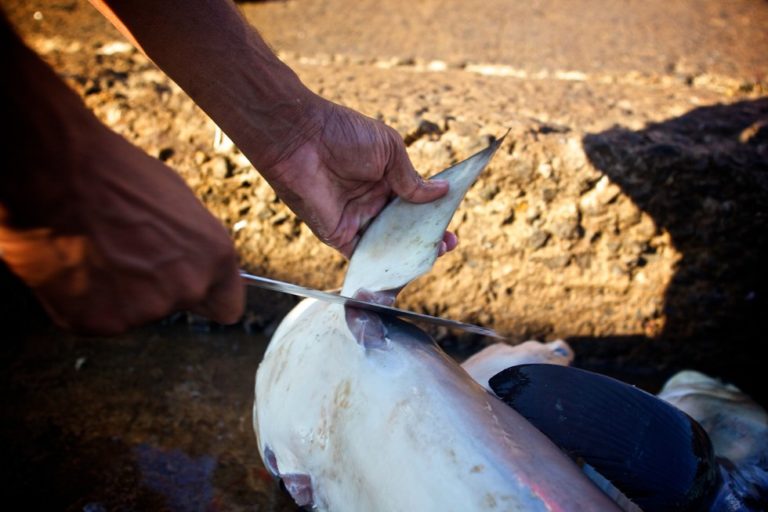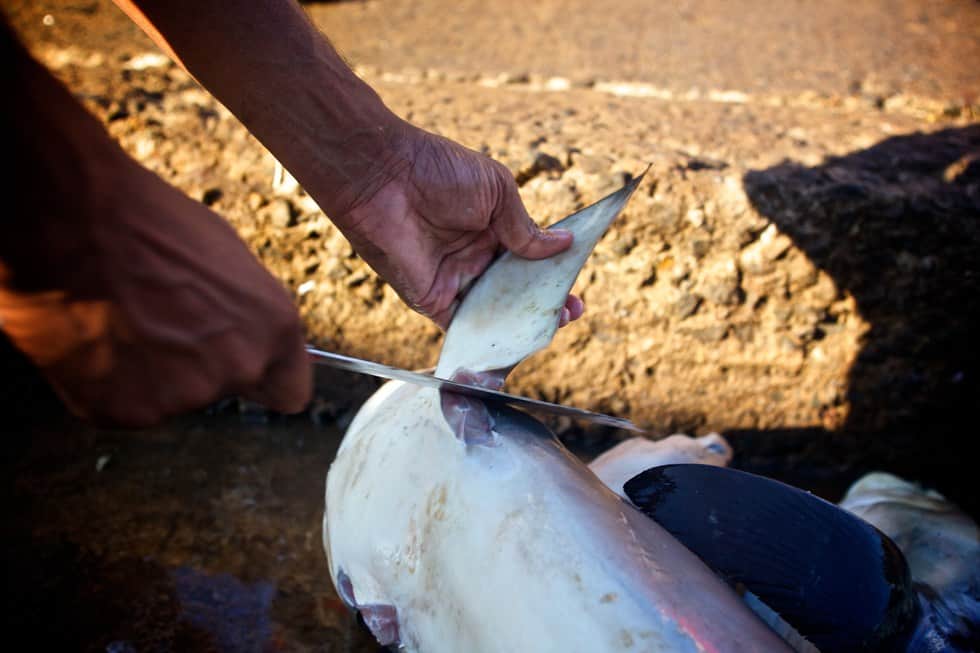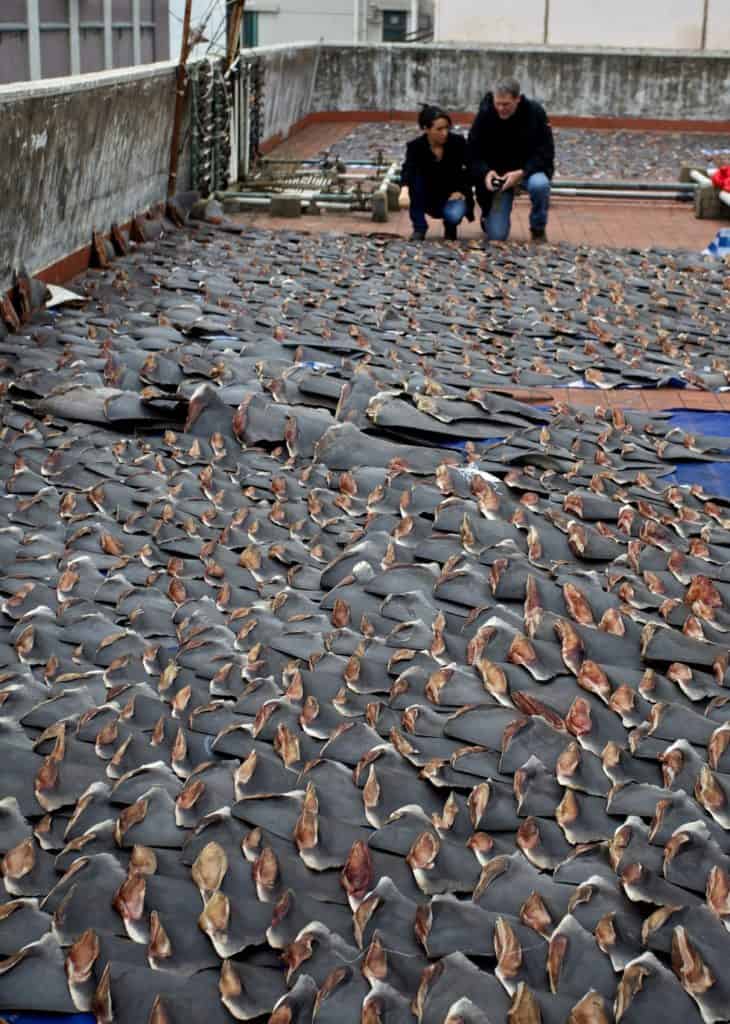
Everyone blames Asia for shark finning, but the U.S. has a part in it, too.
Gary Stokes, the Southeast Asia Director at Sea Shepherd Conservation Society, has lived in Hong Kong for nearly three decades and has learned all there is to know about the illegal practice of shark finning, which is done just for a special soup.
In his effort with the organization to combat this practice, he has seen the fins from the millions of sharks killed annually—73 million, to be exact—and has felt his heartbreak for the poor creatures who are targeted for a dish that’s requested as a sign of wealth.
On one of his trips to locate the incoming source of shark fins, he investigated a rooftop and was horrified at what he saw. When he entered the high-rise rooftop, he saw over 100,000 shark fins being sun-dried. He knew what he would find because he took aerial photos via helicopter first, but didn’t know that the volume would be so immense. He described himself as “numb” when he laid eyes on the fins.

The horrible part about shark finning isn’t just the overwhelming amount of loss, but the suffering that the sharks experience because of it. Without their fins, sharks can no longer move or breathe, making their death long and painful. Joanna Grossman, Federal Policy Advisor for the Animal Welfare Institute explained to The Dodo,
“After being tossed back into the water, the sharks sink further and further; there’s no survival or escape. The animals eventually bleed out and succumb to their injuries, or die from starvation, suffocation, or predation…. For some animals, a slow and painful death awaits while struggling to breathe at the bottom of the ocean; others might be attacked and eaten fairly quickly after being tossed overboard.”

Everyone blames Asia for shark finning, but the U.S. has a part in it, too.

Credit: Gary Stokes
Gary Stokes, the Southeast Asia Director at Sea Shepherd Conservation Society, has lived in Hong Kong for nearly three decades and has learned all there is to know about the illegal practice of shark finning, which is done just for a special soup.
In his effort with the organization to combat this practice, he has seen the fins from the millions of sharks killed annually—73 million, to be exact—and has felt his heartbreak for the poor creatures who are targeted for a dish that’s requested as a sign of wealth.
On one of his trips to locate the incoming source of shark fins, he investigated a rooftop and was horrified at what he saw. When he entered the high-rise rooftop, he saw over 100,000 shark fins being sun-dried. He knew what he would find because he took aerial photos via helicopter first, but didn’t know that the volume would be so immense. He described himself as “numb” when he laid eyes on the fins.

Credit: Gary Stokes
The horrible part about shark finning isn’t just the overwhelming amount of loss, but the suffering that the sharks experience because of it. Without their fins, sharks can no longer move or breathe, making their death long and painful. Joanna Grossman, Federal Policy Advisor for the Animal Welfare Institute explained to The Dodo,
“After being tossed back into the water, the sharks sink further and further; there’s no survival or escape. The animals eventually bleed out and succumb to their injuries, or die from starvation, suffocation, or predation…. For some animals, a slow and painful death awaits while struggling to breathe at the bottom of the ocean; others might be attacked and eaten fairly quickly after being tossed overboard.”

Credit: Gary Stokes
Shark fin soup is known as the food of emperors often served at weddings as a show of prosperity and wealth; a single bowl can cost $100, but it’s the cost to shark lives that is most alarming. Stokes recalls his recent busts, and told The Dodo,
“In the last three weeks alone, I’ve seen three 45-foot containers full of shark fins. One from Indonesia; the other two were both from the United Arab Emirates. When we look at 45-foot containers, we’re talking millions of sharks.”
Hong Kong and mainland China are the major consumers of shark fin soup, despite publicly banning it from official government events and encouraging civil servants not to eat it any longer. A survey from early 2016 revealed that 98 percent of restaurants were still serving the soup and choosing profit over environmental practices.
According to Stokes, countries in Asia are not the only ones to blame in this situation; although shark finning is banned in the U.S., the trading of shark fins is still legal in 39 states. The U.S. continues to allow imports of the fins from countries that allow it, which indirectly shows support for the practice.

Everyone blames Asia for shark finning, but the U.S. has a part in it, too.

Credit: Gary Stokes
Gary Stokes, the Southeast Asia Director at Sea Shepherd Conservation Society, has lived in Hong Kong for nearly three decades and has learned all there is to know about the illegal practice of shark finning, which is done just for a special soup.
In his effort with the organization to combat this practice, he has seen the fins from the millions of sharks killed annually—73 million, to be exact—and has felt his heartbreak for the poor creatures who are targeted for a dish that’s requested as a sign of wealth.
On one of his trips to locate the incoming source of shark fins, he investigated a rooftop and was horrified at what he saw. When he entered the high-rise rooftop, he saw over 100,000 shark fins being sun-dried. He knew what he would find because he took aerial photos via helicopter first, but didn’t know that the volume would be so immense. He described himself as “numb” when he laid eyes on the fins.

Credit: Gary Stokes
The horrible part about shark finning isn’t just the overwhelming amount of loss, but the suffering that the sharks experience because of it. Without their fins, sharks can no longer move or breathe, making their death long and painful. Joanna Grossman, Federal Policy Advisor for the Animal Welfare Institute explained to The Dodo,
“After being tossed back into the water, the sharks sink further and further; there’s no survival or escape. The animals eventually bleed out and succumb to their injuries, or die from starvation, suffocation, or predation…. For some animals, a slow and painful death awaits while struggling to breathe at the bottom of the ocean; others might be attacked and eaten fairly quickly after being tossed overboard.”

Credit: Gary Stokes
Shark fin soup is known as the food of emperors often served at weddings as a show of prosperity and wealth; a single bowl can cost $100, but it’s the cost to shark lives that is most alarming. Stokes recalls his recent busts, and told The Dodo,
“In the last three weeks alone, I’ve seen three 45-foot containers full of shark fins. One from Indonesia; the other two were both from the United Arab Emirates. When we look at 45-foot containers, we’re talking millions of sharks.”
Hong Kong and mainland China are the major consumers of shark fin soup, despite publicly banning it from official government events and encouraging civil servants not to eat it any longer. A survey from early 2016 revealed that 98 percent of restaurants were still serving the soup and choosing profit over environmental practices.
According to Stokes, countries in Asia are not the only ones to blame in this situation; although shark finning is banned in the U.S., the trading of shark fins is still legal in 39 states. The U.S. continues to allow imports of the fins from countries that allow it, which indirectly shows support for the practice.

Credit: Gary Stokes
Due to the small appeal of sharks to humans, especially after Jaws the movie came out, there isn’t enough protection for these creatures even if they’re endangered. At the current rate of finning, sharks are being killed 30 times faster than they can reproduce. This is highly unsustainable, and includes vulnerable and endangered species like scalloped hammerheads and oceanic whitetip sharks.
Fortunately, the culture in Asian countries is changing and younger people are at the forefront of the shift. With the younger generations, less and less people are requesting shark fin soups for their weddings and environmentalists are spreading the word about the horrible practice behind the prized soup.
If you’d like to help sharks, you can sign this petition to ban the shark fin trade in the U.S. or donate to the Sea Shepherd Conservation Society to support their work.
What are your thoughts on shark finning? Please share, like, and comment on this article!
This article (This Conservationist Couldn’t Believe His Eyes When He Entered This Horrible Rooftop) is free and open source. You have permission to republish this article under a Creative Commons license with attribution to the author and TrueActivist.com





solution is simple get persons who doing this cut their hands and feets and put it in ocean to swim